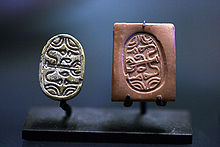
Stamp seal
Encyclopedia

4th millennium BC
The 4th millennium BC saw major changes in human culture. It marked the beginning of the Bronze Age and of writing.The city states of Sumer and the kingdom of Egypt were established and grew to prominence. Agriculture spread widely across Eurasia...
, and probably earlier. They were used to impress their picture or inscription into soft, prepared clay.
Unfortunately, the device of the seal has seldom survived through time; it is usually only their impressions. A major exception are the cylinder seal
Cylinder seal
A cylinder seal is a cylinder engraved with a 'picture story', used in ancient times to roll an impression onto a two-dimensional surface, generally wet clay. Cylinder seals were invented around 3500 BC in the Near East, at the contemporary site of Susa in south-western Iran and at the early site...
s made of stone, of which examples of their ancient impressions have survived as well, the majority being of clay tablet
Clay tablet
In the Ancient Near East, clay tablets were used as a writing medium, especially for writing in cuneiform, throughout the Bronze Age and well into the Iron Age....
s sealed as an authentication.
Indus stamp-seal
Different from the Minoan stamp-sealMinoan seal-stones
Minoan seal-stones are gemstones, or near-gem-quality stones produced in the Minoan civilization. They were found in quantity at specific sites, for example the Citadel of Mycenae....
s, the Indus stamp-seals probably have a different function from the stamp seals of the Minoan civilization
Minoan civilization
The Minoan civilization was a Bronze Age civilization that arose on the island of Crete and flourished from approximately the 27th century BC to the 15th century BC. It was rediscovered at the beginning of the 20th century through the work of the British archaeologist Arthur Evans...
, as they typically have script characters, with still undeciphered associations.
See also
- LMLK sealLMLK sealLMLK seals were stamped on the handles of large storage jars mostly in and around Jerusalem during the reign of King Hezekiah based on several complete jars found in situ buried under a destruction layer caused by Sennacherib at Lachish...
s from LachishLachishLachish was an ancient Near East town located at the site of modern Tell ed-Duweir in the Shephelah, a region between Mount Hebron and the maritime plain of Philistia . The town was first mentioned in the Amarna letters as Lakisha-Lakiša...
, ca 700 BCE. - MMSTMMSTMMST appears exclusively on LMLK seal inscriptions, seen in archaeological findings in Israel, and its meaning has been the subject of continual controversy.-ממשת transliterations into English:...
- Tell HalafTell HalafTell Halaf is an archaeological site in the Al Hasakah governorate of northeastern Syria, near the Turkish border, just opposite Ceylanpınar. It was the first find of a Neolithic culture, subsequently dubbed the Halaf culture, characterized by glazed pottery painted with geometric and animal designs...
- Impression sealImpression sealThe impression seal is a common seal that leaves an impression, typically in clay and less often in wax. In antiquity they were common, largely because they served to authenticate legal documents, such as tax receipts, contracts, wills and decrees...
- Cylinder sealCylinder sealA cylinder seal is a cylinder engraved with a 'picture story', used in ancient times to roll an impression onto a two-dimensional surface, generally wet clay. Cylinder seals were invented around 3500 BC in the Near East, at the contemporary site of Susa in south-western Iran and at the early site...
- Bulla (seal)Bulla (seal)Bulla , is a type of seal impression. It comes in two forms: metal and clay.- Clay bullae :The original bulla was a lump of clay molded around a cord and stamped with a seal...
- Indus scriptIndus scriptThe term Indus script refers to short strings of symbols associated with the Indus Valley Civilization, in use during the Early Harappan and Mature Harappan period, between the 35th and 20th centuries BC. In spite of many attempts at decipherments and claims, it is as yet undeciphered...
External links
- Detail of Stamp seal-Medium Res;
- Article mcclungmuseum.utk.edu—Jar, and associated Stamp Seal
- Gazelle Head, Stamp seal – at the Oriental Institute of Chicago.

